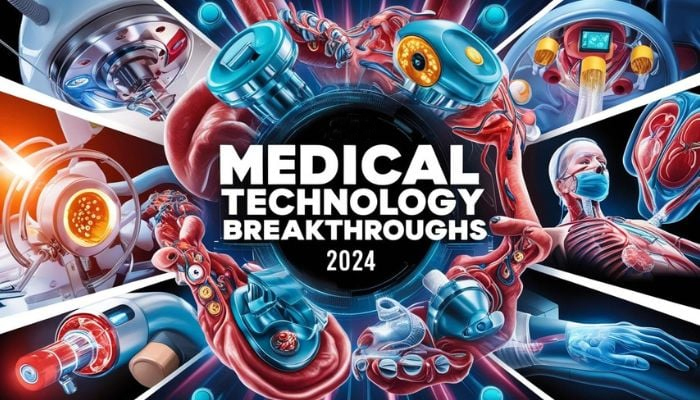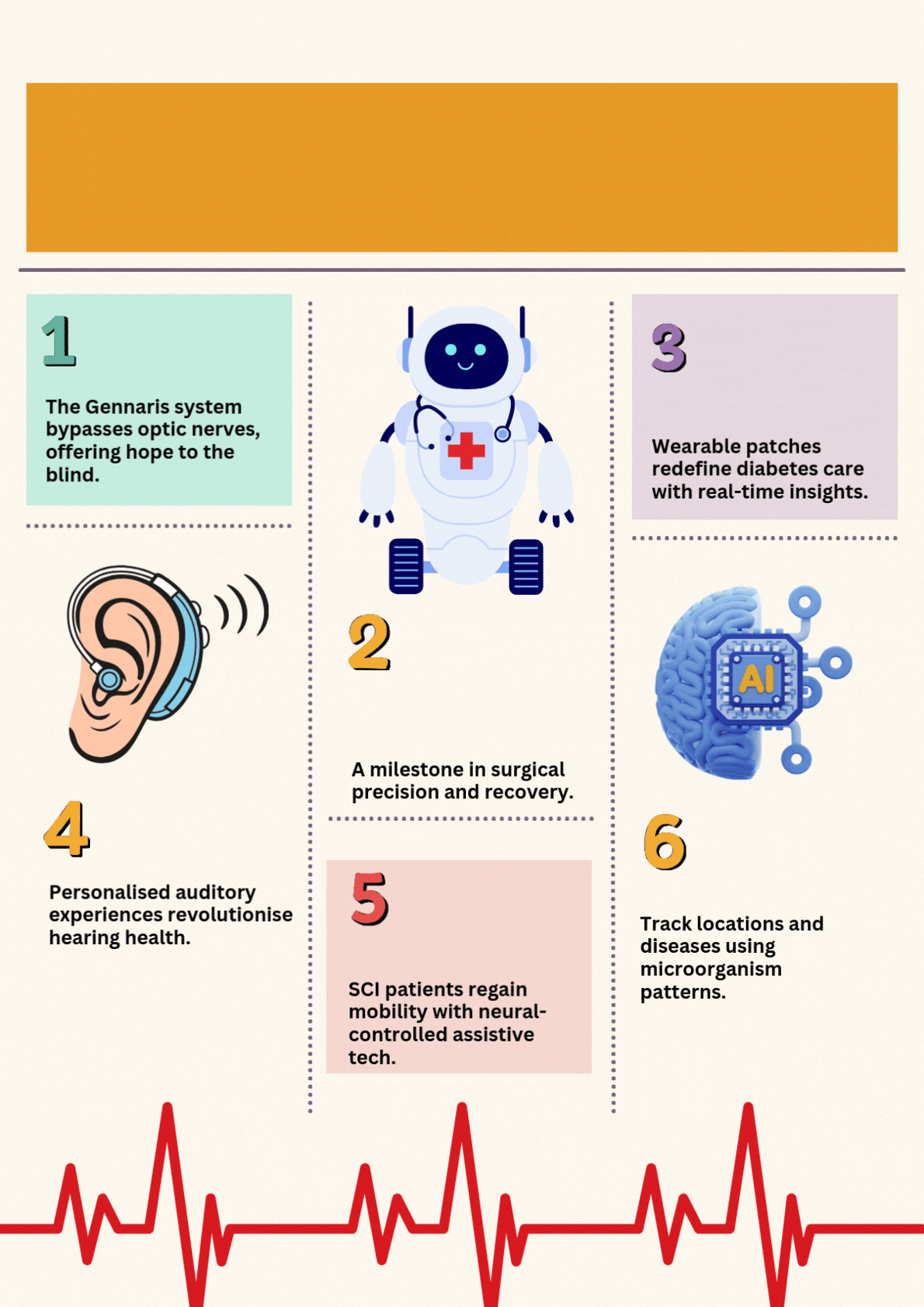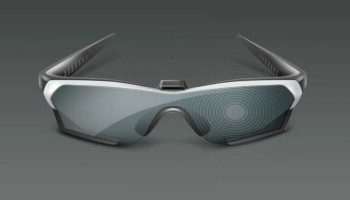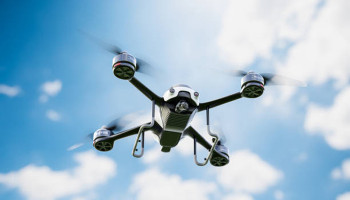
Medical technology has reached extraordinary heights in 2024, transforming how we diagnose, treat, and monitor complex health conditions. From revolutionary vision restoration systems and robotic surgeries to advancements in glucose monitoring, hearing aids, and brain-machine interfaces, these innovations offer renewed hope for patients worldwide.
Gadinsider explores some of the most notable breakthroughs of the year, highlighting their impact on healthcare.
Vision restoration with the Gennaris Bionic Vision System
Blindness, long considered an irreversible condition, is now within the scope of groundbreaking technological solutions. Researchers at Monash University in Australia have developed the world’s first bionic eye, the ‘Gennaris Bionic Vision System,’ bringing hope to millions living with blindness.
The Gennaris system bypasses damaged optic nerves and sends signals directly to the brain. This is achieved using wireless implants placed on the brain’s surface, which stimulate neurons in the visual cortex. A miniature camera embedded in custom headgear captures high-resolution images, processes them, and transmits them wirelessly to the implants.
What sets the Gennaris system apart is its ability to replicate the retina’s concave shape, resulting in a more natural vision experience. Although the device currently provides a 100-degree field of view—slightly narrower than the human eye’s 130-degree range—advances in nanowire technology have significantly improved its processing speed.
After nearly a decade of development, human trials are underway in Melbourne. Initiated in 2020, this revolutionary study is setting the stage for future advancements in vision restoration.

The first robotic double-lung transplant
In a world-first, surgeons at NYU Langone Health performed a fully robotic double-lung transplant, demonstrating the immense potential of robotic surgery. The procedure, led by Dr Stephanie Chang, surgical director of the Lung Transplant Program, utilised the advanced da Vinci Xi robotic system to replace the lungs of Cheryl Mehrkar, a 57-year-old COPD patient.
This cutting-edge system, equipped with precision-guided robotic arms, enabled surgeons to make minimal incisions, ensuring better visualisation and improved patient outcomes. Following the procedure, Mehrkar shared: “I’m so grateful to the donor and medical team for giving me another chance at life.”
This landmark accomplishment sets a new benchmark for transplant procedures, enhancing surgical precision while reducing recovery times, and offering hope to countless patients worldwide.
Advancements in glucose monitoring wearables
For people with diabetes, monitoring blood sugar levels is a vital but often invasive process. In 2024, revolutionary non-invasive glucose monitoring skin patches connected to smart devices have transformed diabetes management.
These wearables provide real-time data, making continuous glucose monitoring (CGM) more accessible and efficient. Companies like Dexcom are at the forefront of this innovation, introducing devices like the Stelo monitor, which caters to users with Type 2 diabetes. These monitors offer precision and convenience, empowering users to manage their blood sugar levels effectively.
Speaking to Gadinsider, Dr Kainat Fatima, a doctor at Sindh Government Children's Hospital, remarked: “Continuous Glucose Monitors (CGMs) are efficient, non-invasive methods for blood glucose monitoring. These devices continuously monitor random blood sugar (RBS) levels in real-time, eliminating the need for repeated finger pricks.”
However, Dr Fatima pointed out that traditional glucometers, while invasive, remain more accurate than CGMs. “Pakistani users tend to prefer glucometers due to their accuracy and reliability,” she added.
AI-powered hearing aids: A new era in auditory health
Hearing aid technology has undergone a seismic shift in 2024, driven by artificial intelligence and sophisticated signal processing. Split-processing hearing aids now manage speech and environmental sounds independently, delivering an immersive auditory experience tailored to individual needs.
Companies like HearUSA are leveraging AI to enhance sound quality, minimise background noise, and provide seamless device connectivity. These hearing aids continuously learn and adapt, ensuring a personalised auditory experience. Remote care technology also allows users to adjust settings and receive professional support from anywhere, enhancing convenience.
Beyond assistive devices, these innovations signify a paradigm shift in auditory health. AI-driven hearing aids are poised to reshape the future, offering improved outcomes for users globally.
Speaking to Gadinsider, Senior Registrar and ENT Specialist at Medicare Hospital, Dr Saad, stated: "This cost-effective treatment has the potential to transform auditory health, and the government should prioritise funding and awareness campaigns to ensure accessibility, reducing social bullying associated with hearing impairment and make this technology accessible to a wider population to benefit from these advancements.”
Brain-machine interfaces for spinal cord injuries
Brain-machine interfaces (BMIs) are opening new avenues for individuals with spinal cord injuries (SCI), enabling them to regain voluntary control and mobility. These advanced systems establish direct communication between the brain and external devices, such as prosthetics and exoskeletons, allowing users to control them through neural signals.
A notable innovation in this field is spinal cord epidural stimulation (scES), which generates targeted neural signals to restore movement. Complementing these technologies are biological therapies like “dancing molecules,” which stimulate cell repair and regeneration.
These breakthroughs represent a significant leap in SCI treatment, improving the quality of life for patients and offering new possibilities for rehabilitation.
AI tracks locations using microorganisms
Researchers at Lund University in Sweden have unveiled an AI tool capable of determining an individual’s location with 92% accuracy by analysing microorganisms such as fungi, algae, and bacteria present on the body. This system, known as the Microbiome Geographic Population Structure (mGPS), maps locations based on region-specific microbial patterns.
Lund researcher Eran Elhaik explained that in contrast to human DNA, the human microbiome changes constantly when we interact with different environments.
By tracing these microbial signatures, the tool has applications in tracking disease spread, identifying infection sources, and even forensic investigations. This innovative use of AI underscores the potential of harnessing microbiomes for public health and scientific advancements.
PhD Research Fellow at the University of Sydney, Dr Sidra Rafi, told Gadinsider: “Each continent hosts distinct microbiomes, which are beneficial to the human body. However, under favourable conditions, they can become opportunistic. For mGPs to be effective, they require access to extensive, localised data. The more data they collect, the more robust and valuable their insights become.”
Dr Sidra further advocated for the integration of this technology in Pakistan but emphasised that its use must be diligently monitored to prevent “bioterrorism”. If implemented responsibly, mGP technology holds significant potential for advancing healthcare and microbiome research in Pakistan.
Transforming lives through medical innovation
The advancements of 2024 mark a pivotal year for medical technology, demonstrating its transformative potential across diverse fields. From restoring sight and enabling complex surgeries to managing chronic conditions and unlocking the mysteries of human microbiomes, these breakthroughs have set new standards in healthcare.
As we continue to explore the possibilities of these technologies, the future holds immense promise for improved patient outcomes and a better quality of life. Through sustained research and collaboration, the next wave of innovations could redefine the boundaries of modern medicine, offering solutions to challenges once deemed insurmountable.
Story visualisation by Afreen Mirza.
















